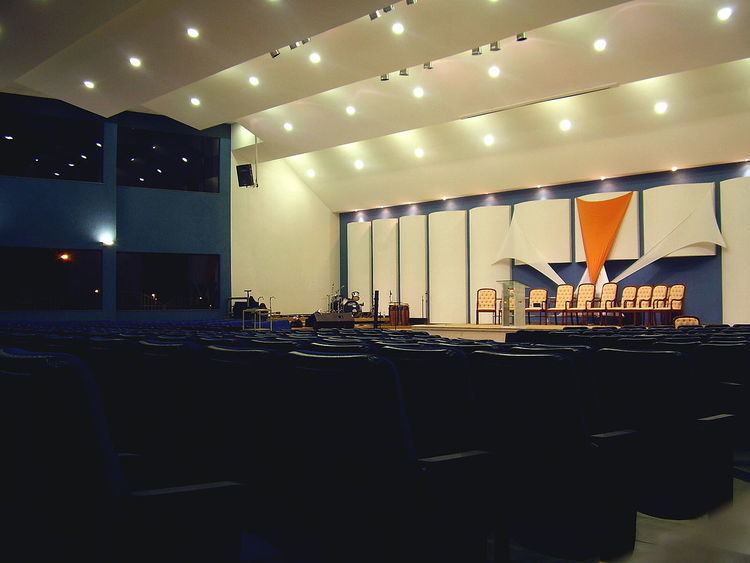Classification Protestant Associations Assembly of God | Region Worldwide | |
 | ||
Leader José Wellington Bezerra da Costa (President of CGADB) | ||
The Assembléias de Deus ([ɐsẽˈblɛjɐz dʒi ˈdeos]) are a group of Pentecostal denominations in Brazil founded by Daniel Berg and Gunnar Vingren who came to Brazil as missionaries from the Swedish Pentecostal movement. Assembleias de Deus are related to worldwide Pentecostal movement, and some groups are affiliated with the Assemblies of God. Currently, the organization is one of the largest Protestant denominations worldwide.
Contents
History
The Assembléias de Deus began when Daniel Berg and Gunnar Vingren, two Swedish Pentecostal missionaries departed to Brazil. They arrived in Belém, Pará, where in 1911 founded the Missão de Fé Apostólica, which later changed its name in 1918 to "Assembleia de Deus".
The Pentecostal movement in Brazil had already been started by that time among Italians in São Paulo, by an Italian-American missionary, Louis Francescon, who initiated the Christian Congregation of Brazil (CCB) in 1910. While the CCB spread in the South, the Assembleias de Deus reached the Amazon villages and the semi-arid Nordeste before migrants from the North brought the Church to Rio de Janeiro and São Paulo in the late 1920s.
Initially the Assembleia de Deus was intimately linked to the Scandinavian Pentecostal movement, led by Lewi Pethrus, who financed and sent missionaries to help Berg and Vingren. The Swedish Pentecostals gave autonomy to the Brazilian Assembleia de Deus in a General Convention in 1932. From that time onward, the American Assemblies of God increased their presence, mainly on doctrinal and teaching spheres, on the Brazilian denomination, but retained its independence from their American brethren. Walter Hollenweger explains such relation as follows: "In the mission statistics of the North American Assemblies of God, the Assembleia de Deus figure as their mission church. In contrast, the Brazilian Pentecostals regard themselves as an independent church."
Schism
Since the 1980s the Assembleias de Deus have suffered several schisms and splits. As a consequence, many Conventions and Ministérios left using the same name "assemblea de Deus", though being totally independent organizations. The most significant denominations named Assembleias de Deus are:
Altogether, the churches that bear the name Assembleias de Deus in Brazil had 8.5 million adherents in 2001.
Foreign Work
The Brazilian Assembleia de Deus has always sent missionaries abroad, starting in 1913 when a returning Portuguese immigrant was commanded to Portugal. Today, there are Brazilian missionaries in Latin America and in the Portuguese-speaking Africa. There also are Brazilian Assemblies of God among the Brazilian immigrant communities in North America, Japan, and Western Europe, but usually they do not have relations with the local World Assemblies of God Fellowship affiliated national denominations.
In the United States there are a Brazilian Assembleias de Deus, mostly in the Eastern Coast, some are affiliated with the Brazilian District of the Assemblies of God, but the majority of the Brazilian churches are either independent or linked to their ministério back in Brazil.
Organization
The Assembleias de Deus have a non-territorial episcopal polity (called Ministerio) where each Ministerio is a directed by a mother-church under a pastor-president (also called bishop or apostle in various Ministerio) with affiliated congregations and preaching points. The mother-church receive tithes and manages the funds of the affiliated local churches, as well as assign pastors for the local congregations. There is a strong influence of pastoral leadership on the decision-taking process, and the members only rubber stamp the Ministerio decisions.
As the ministerio structure overlaps many territorial boundaries, there usually is no much organizational collaboration among ministérios. Virtually, each ministério operates independently, and end up becoming an independent denomination on itself. Among the major ministérios stands the Assembly of God Bethlehem Ministry, which has about 2,200 churches concentrated in the south-central and headquartered in Belenzinho neighborhood in São Paulo. In 2008, Ministério do Belém was chaired by Pr José Wellington Bezerra da Costa, who succeeded Pr. Cicero Canuto de Lima, who also chaired the CGADB.
Since the 1980s, for administrative reasons, notably after the death of Paul Leiva Macalão pastor and his wife, Zelia missionary, the Brazilian Assembly of God has undergone several divisions that gave rise to various conventions and ministries with autonomous administration in various regions of the country The most significant of the independent ministries are the Ministry of Madureira, whose church has existed since the 1930s, founded by the aforementioned Pr. Paul Leiva Macalão and, in 1958, served as the basis for structuring national Ministry chaired by him until his death in late 1982.
Doctrine
Since it is not a unified movement, there are many variations in doctrine and practice in the Assembleias de Deus in Brazil, but in common they believe in the Bible as the sole source of doctrine, the vicarious death of Christ, in the baptism of adults by immersion in water, in Holy Communion with no wine, the obligation of the tithe, the gifts of the Holy Spirit, and the premillennial return of Jesus, consider Christian headcovering for woman in worship and kiss of peace as heresies.
